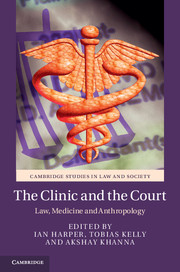Book contents
- The Clinic and the Court
- Cambridge Studies in Law and Society
- The Clinic and the Court
- Copyright page
- Contents
- Contributing Authors
- Book part
- Introduction
- Part One Recognising harm and suffering
- Part Two Understanding and allocating remedy
- Chapter Seven Thejuridical hospital: claiming the right to pharmaceuticals in Brazilian courts
- Chapter Eight Courts and thecontrol of TB: Quarantine, travel and the question of adherence
- Chapter Nine Dying to go to court: Demanding a legal remedy to end-of-life uncertainty
- Chapter Ten Rehabilitation of paedophiles at the intersection of law and therapy
- Chapter Eleven A republic of remedies:Psychosocial interventions in post-conflict Guatemala
- Index
- Series page
- References
Chapter Ten - Rehabilitation of paedophiles at the intersection of law and therapy
from Part Two - Understanding and allocating remedy
Published online by Cambridge University Press: 05 May 2015
- The Clinic and the Court
- Cambridge Studies in Law and Society
- The Clinic and the Court
- Copyright page
- Contents
- Contributing Authors
- Book part
- Introduction
- Part One Recognising harm and suffering
- Part Two Understanding and allocating remedy
- Chapter Seven Thejuridical hospital: claiming the right to pharmaceuticals in Brazilian courts
- Chapter Eight Courts and thecontrol of TB: Quarantine, travel and the question of adherence
- Chapter Nine Dying to go to court: Demanding a legal remedy to end-of-life uncertainty
- Chapter Ten Rehabilitation of paedophiles at the intersection of law and therapy
- Chapter Eleven A republic of remedies:Psychosocial interventions in post-conflict Guatemala
- Index
- Series page
- References
- Type
- Chapter
- Information
- The Clinic and the CourtLaw, Medicine and Anthropology, pp. 239 - 264Publisher: Cambridge University PressPrint publication year: 2015

